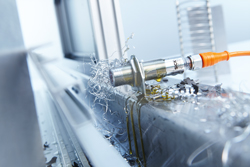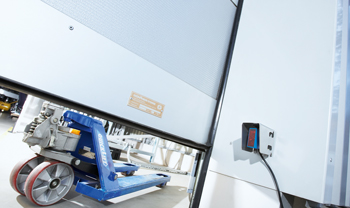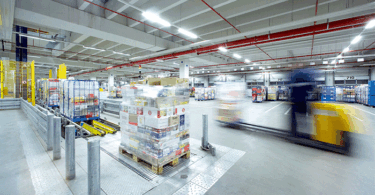We all know how our bodies are affected by environmental conditions. Be it the weather, extreme cold or heat, poor visibility, wet, dry, or other significant environmental influences – we have to face up and adapt. Things are no different in the world of sensors. Here too, the standard solution often falls short of requirements. Innovations are the order of the day. Without innovations, industrial processes simply would not happen.
 SICK’s portfolio includes Hygienic Design sensors and mounting solutions which are able to withstand daily high-pressure cleaning and exposure to water. Sensors for use in explosive environments must be certified to international product standards.
SICK’s portfolio includes Hygienic Design sensors and mounting solutions which are able to withstand daily high-pressure cleaning and exposure to water. Sensors for use in explosive environments must be certified to international product standards.
High mechanical stresses demand very rugged sensors inside housing designs of a similar type. Sensors from SICK are also ideal for applications in outdoor environments where climatic conditions are challenging (traffic data management and building automation, for example, as well as door, shutter, and gate applications).
Sensors for Hygienic and Wet Areas: Clean and Watertight
In both the pharmaceuticals and the food and beverage industries, for example, the wet environment is not the only challenge to be faced. The sensors must also be able to withstand the high pressure cleaning of equipment on a daily basis, during which they are exposed to high thermal and mechanical stress or dramatic temperature variations and heat.
 The high-quality stainless steel housing with PTFE sealing rings provides protection against aggressive disinfectants, high-pressure cleaning, cleaning with foam or subsequent rinsing. It is entirely resistant to all such processes. The use of O-rings means that there are no longer any bore holes or mechanical contact surfaces.
The high-quality stainless steel housing with PTFE sealing rings provides protection against aggressive disinfectants, high-pressure cleaning, cleaning with foam or subsequent rinsing. It is entirely resistant to all such processes. The use of O-rings means that there are no longer any bore holes or mechanical contact surfaces.
Explosive Environments Need sensors that are Rugged and Fireproof
Potentially explosive atmospheres can arise wherever dust, flammable gases, or flammable liquids are manufactured, transported, processed, or stored. A general distinction is made between primary and secondary explosion protection. Primary explosion protection: primary explosion protection concerns measures for monitoring the concentration of oxygen or combustible substances (approx. 80% of all industrial dust is explosive!). The aim is to prevent the formation of a potentially explosive atmosphere. Secondary explosion protection involves measures targeted at preventing sources of ignition inside or on a device.
SICK offers certified solutions for the main types of ignition protection: protection provided by housing, pressure-resistant casing, intrinsic safety, increased safety, and pressurized apparatus. Therefore, sensors must be designed to exclude the risk of explosion (as a result of their housing getting hot, for example) yet, at the same time, they must be rugged enough to be protected against possible explosions (so that they in turn can be used to monitor explosive environments).
Doors, Shutters, and Gates: Leaving Nothing to Chance
 Sensors from SICK are used at doors, shutters, and gates, as well as indoors and outdoors. Photoelectric sensors and automation light grids protect automatic gates against the risk of vehicle collisions. At airports, light grids protect automatic gates against the risk of vehicle collisions. At airports, light grids monitor the passage of people through safety gates, where they also prevent objects getting through to airside (i.e. to the aircraft).
Sensors from SICK are used at doors, shutters, and gates, as well as indoors and outdoors. Photoelectric sensors and automation light grids protect automatic gates against the risk of vehicle collisions. At airports, light grids protect automatic gates against the risk of vehicle collisions. At airports, light grids monitor the passage of people through safety gates, where they also prevent objects getting through to airside (i.e. to the aircraft).
Outdoors in particular, operators are looking for gates with short opening and closing times. The longer an external gate remains open unnecessarily, the more heating and air conditioning energy is released in to the air. As long as the sensors detect an obstruction in the opening of a roller shutter, for example, they will block the automatic closing process. If there are no obstacles in the way, they will ensure that the shutter closes automatically.
Outdoor Sensors: Impervious and Innovative
Sensors for outdoor applications must not be sensitive to climatic influences. They are exposed to rain, snow, wind, strong sunlight, dust, fog, cold, and heat. Whether outside airports, buildings, in ports or on roads, rail, or at sea – the sensors used to detect objects or people in such challenging ambient conditions must be highly available and very reliable. SICK has developed technological innovations in which sensors and systems work in skilled partnership in challenging outdoor conditions.
In the future, systems will have to make autonomous decisions. For sensor technology, this means that reliable data is becoming increasingly important, since the correct decision can only be made if the sensor is able to capture real-life situations without encountering any problems even under adverse environmental conditions.





